
The Mango House is a building in Amman, Jordan. Situated on Mango Street, the house looks out toward Jabal Akhddar on the other side of the valley that is downtown Amman.

The Mango House is a building in Amman, Jordan. Situated on Mango Street, the house looks out toward Jabal Akhddar on the other side of the valley that is downtown Amman.

The Mango House was designed by architect Mukhtar Saqr, who had also designed the close-by Al Bilbeisi House II. Located on Jabal Amman, the Mango House is an example of a new style of Jordanian architecture and differs greatly from the houses built in the area during the 1920s and 30s, as well as from its 1940s contemporaries. [1] The house is built with smooth rose stone and has numerous wrap-around balconies. [1] A similarity to other 1940s houses is the clear separation of rooms, instead of using a more traditional tripartite plan. [1] The Mango House is built in two separate halves, so as to accommodate the two brothers living there when it was built. [1]
The Mango House was built in the late 1940s by the brothers Kamal and Ali Mango, sons of Hamdi Mango, [1] who were part of one of Amman's primary business dynasties during the era. [2] Built on Omar bin al-Khattab Street (later dubbed Mango Street), the house was close in location to several other houses, south of Habboo and Akrawi House, and across the street from al-Mufti House. When the Mango House was built, the Mango family also owned several other houses on Mango Street. During the 1970s, the interior of the upper floor was remodeled. The upper unit was revamped even further when, in 1995, a two-room penthouse was added. [1] The Mango family continues to occupy the house today.

Amman is the capital and largest city of Jordan, and the country's economic, political, and cultural center. With a population of 4,061,150 as of 2021, Amman is Jordan's primate city and is the largest city in the Levant region, the fifth-largest city in the Arab world, and the ninth largest metropolitan area in the Middle East.

Al-Salt is an ancient salt trading city and administrative centre in west-central Jordan. It is on the old main highway leading from Amman to Jerusalem. Situated in the Balqa highland, about 790–1,100 metres above sea level, the city is built in the crook of three hills, close to the Jordan Valley. One of the three hills, Jabal al-Qal'a, is the site of a 13th-century ruined fortress. It is the capital of Balqa Governorate.

Al-Faisaly Sports Club is a professional football club based in Amman, Jordan, that competes in the Jordanian Pro League, the top flight of Jordanian football. Nicknamed "the Blue Eagles", they were founded as Al-Ashbal Club in 1932.
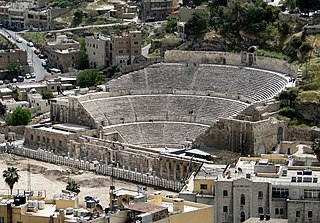
Roman Theatre of Amman is a 6,000-seat, 2nd-century Roman theatre. A famous landmark in the Jordanian capital, it dates back to the Roman period when the city was known as Philadelphia. The theatre and the nearby Odeon are flanking the new Hashemite Plaza from the south and the east respectively, while the Roman Nymphaeum is just a short stroll away in north-westerly direction.
The Umayyad desert castles, of which the desert castles of Jordan represent a prominent part, are fortified palaces or castles in what was the then Umayyad province of Bilad al-Sham. Most Umayyad "desert castles" are scattered over the semi-arid regions of north-eastern Jordan, with several more in Syria, Israel and the West Bank (Palestine).
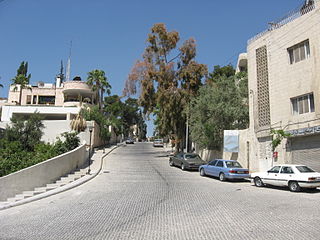
The Rainbow Street, originally named Abu Bakr al Siddiq street, is a public space in the historic area of Jabal Amman, near the center of downtown Amman, Jordan. The street runs east from the First Circle to Mango Street, and contains several attractions from roof top restaurants to pubs. The street runs in front of the British Council building, as well as the headquarters of the Jordan Petroleum Refinery Company and the cinema after which the street is renamed.

Mango Street is a historic street in the Jabal Amman area near downtown Amman, Jordan. Officially named Omar bin al-Khattab Street, the street derives its nickname from the Mango House, a building on the intersection between Mango and Rainbow Streets. Mango Street has an assortment of historic buildings, many being Ottoman, and across the street from the Mango House is Al-Mufti House. Books@Cafe and other locations such as Old View Cafe line the street.

The Mufti House is a house located on Rainbow Street-Mango Street intersection in the Jabal Amman neighbourhood of Amman, Jordan. Like many other houses in Jabal Amman, such as the Mango House across the street, 70 years has given the Mufti House time for a significantly wooded front yard to develop. A stair-stepped stone wall covered in ivy separates it from the main street.
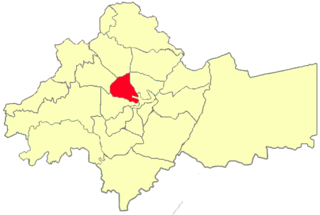
Abdali is an area in the Greater Amman Municipality, it is named relative to King Abdullah I who founded it during the 1940s. It covers an area of 15 square kilometres (6 sq mi) in the heart of Amman, with a population of 165,333 in 2015. Large parts of the district are residential, but due its geographical location in the center of the city, it contains several important governmental buildings and businesses. The area is known for containing several bus stations serving routes to many cities in Jordan.

The Amman Citadel is an archeological site at the center of downtown Amman, the capital of Jordan. The L-shaped hill is one of the seven hills (jabals) that originally made up Amman.
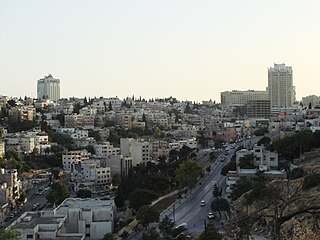
Jabal Amman neighborhood is one of the seven hills that originally made up Amman, Jordan. Today, Jabal Amman is near the downtown area.

Rujm Al-Malfouf is one of a series of watchtowers from the Ammonite kingdom in modern day Amman, Jordan. Its name can be directly translated as the Hill of the Twisted [Stone], which derives from the tower's circular shape. Built in the first half of the first millennium BC, the watchtower is located on Jabal Amman. Rujm Al-Malfouf is next to the Jordanian Ministry of Antiquities.
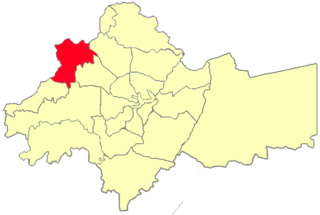
Sweileh is district number sixteen in Amman, Jordan out of twenty-seven. It lies to the north of the city center. It was founded by Chechen settlers in 1906 during Ottoman rule. It had a population of 151,016 in the 2015 census. The town is known for having a good climate throughout the year, it is one of the few districts of Amman that sees snow during winter due to its high altitude. The cultivation of olives and grapes, heavy industries, such as auto assembly, steel, and cement, make up the local economy. Today, it is considered one of Amman's most populated districts since it has the University of Jordan and is a connection point to other cities such as Salt, Irbid and Jarash.
The following is a timeline of the history of the city of Amman, Kingdom of Jordan.

The Umayyad Palace is a large palatial complex from the Umayyad period, located on the Citadel Hill of Amman, Jordan. Built during the first half of the 8th century, it is now largely ruined, with a restored domed entrance chamber, known as the "kiosk" or "monumental gateway".

Zahran is an area in the Greater Amman Municipality. It is named after the Zahran Palace which stands amidst Zahran street. It consists of 5 neighborhoods of which most parts are residential, however, some parts of the district contain Amman's best hotels, hospitals and towers. The district is also home to several governmental buildings, embassies, cultural centers and schools. Zahran area stretches from 1st circle to between 5th and 6th circles, and from North Abdoun to South Abdoun.

Belbeisi Palace is a historic palace located in Amman, Jordan, in the first circle in Jabal Amman. It was the property of Ismail Pasha Bilbeisi, who came from the town of Salt to Amman in the 1920s. The building was one of the first palaces in the kingdom and now serves as a museum of traditional arts. It is considered one of the finest examples of traditional Arab architecture in Amman. King Abdullah I, the first monarch of Jordan, used it to entertain guests.

The architecture of Jordan has been subject to vast development, specifically in the final years of the twentieth century. Jordan is a semi-arid country located in the Middle East. Its location has great significance to Christians, Muslims and Jews as it is considered part of the Holy Land.
Rami Daher is a Jordanian architect, academic, and public intellectual specialized in architectural conservation and urban design. He is currently associate professor at the School of Architecture and Built Environment at the German Jordanian University and general director of TURATH, an architectural and urban design consultancy in Amman, which has executed several major interventions in historic and heritage settings.